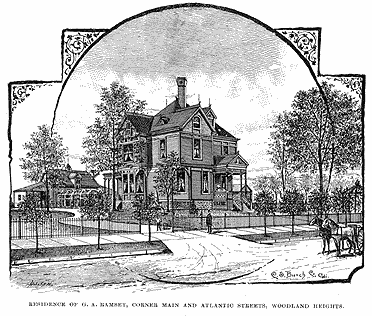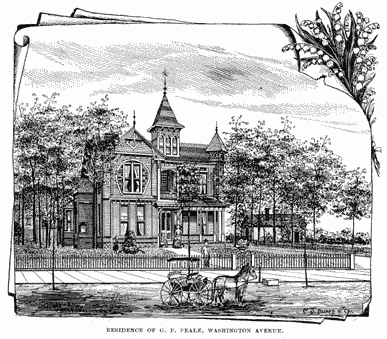SPRINGFIELD, MISSOURI AND SURROUNDINGS • 1889
(previous page) effort on the part of our people. The new rustlers who are fast settling down among us, will make Springfield hum in the next ten years.
Mr. Geo. A. C. Wooley, of the well known real estate and loan firm of Wooley, Porter & Hubbell, than whom there is not a more competent judge of the material interests of the city within its borders, thinks Springfield will have 75,000 people in ten years, and bases his opinion on the natural increase of a thrifty population; the early inflow of mechanics for the new Gulf Railway shops, the new Car and Foundry Company’s works; the Pennsylvania Ice Company’s works, and a good number of other industries now being planted here, and the early completion of several new trunk railway lines.
Col. J. W. Lisenby, one of the leading public spirited real estate men of the city, and a gentleman of capital judgment, says all indications point to a city of 60,000 or more people at an early day. The remarkable growth of the past five years is based upon causes that promise even greater results in the five years to come. We have 15,000 square miles of tributary country, rich in minerals and agriculture, and the poorest of our woodlands are proving to be the finest fruit growing lands in the union.
Col. Homer F. Fellows, the president of the Springfield Wagon Company, and for the last fifteen years influential worker for many of the leading public enterprises of the city, thinks Springfield has the best natural location of any town in the Southwest; that it will soon have the most natural and available railway route to the Pacific, and within five years a population of 50,000. So manifold and manifest are its advantages that the same element that made Kansas City and Wichita, would have made Springfield a city of 150,000 people to-day.
M. P. B. Perkins, the builder and owner of the Perkins Grand Opera House, the builder of the Springfield Water Works and the Perkins Foundry, and, like Col. Fellows, a man of boundless public spirit, whose building enterprises in the last seven years cover close to half a million dollars, says: Only unity, enterprise and public spirit are needed to make Springfield one of the foremost cities in the West.
Mr. J. S. Boreman, a capital young business man, whose liberal experience in town-building at various points in Southwest Missouri, gives value to his opinions in this connection, puts the population of the city in 1890 at 75,000, and says if these figures are not realized the lesson of our growth and prosperity has little significance.
Mr. L. T. Bell, a well known drug merchant, whose real estate investments here have been especially fortunate, and whose sound conservative views are highly regarded, thinks the city will double its present population in ten years. The large extent of tributary country and steady infusion of new blood and enterprise from without are greatly in its favor. We have built from 400 to 600 homes in each of my four years’ residence in Springfield, and are still far behind the demand. Our growth is due more to extraneous forces than to my effort of our own people.
Mr. A. J. Minard, of the enterprising real estate firm of Minard & Griffith, says 60,000 is a low estimate for the population of the city ten years hence, and nothing but the indifference of the people will prevent the building of a much larger town. His equally sagacious and public spirited partner, Mr. D. L. Griffith, puts the population for the next decade at 75,000, and bases his opinion on the certainty of three more trunk railways, the rapid discovery and development of new mines, and the liberal investment of outside capital.
Capt. Joseph Fisher, the president and manager of the Ozark Lumber Co., and one of the most capable and clear-sighted business men in the Southwest, believes in a bright future for Springfield, and bases his judgment upon the great natural wealth of the tributary country, which covers a radius of 125 miles of territory, whose forest, mineral and agricultural wealth is yet largely undeveloped.
Dr. G. S. Catlin, one of the livest and most public spirited men in the city, and the head of the well-known real estate firm of G. S. Catlin & Co., says Springfield is surely growing into a city of 100,000 people. He thinks the tributary country will easily take care of that, or even a greater population.
Mr. G. F. Reed, an accomplished artist and designer, whose mechanical impress is on many of the finest homes and business houses of the city, predicts his belief in a bright future for Springfield, upon the fact that within the last three years 1500 homes have been built, and still the demand is beyond the supply. That 600 new homes are now under contract, or construction, and every one of them will be in use by the close of the year.
Mr. A. Doneghy, who recently located here in the boot and shoe trade after a careful canvass of the entire Southwest, and whose clear forecast, (next page)
Page
1 | 2 | 3 | 4 | 5 | 6 | 7 | 8 | 9 | 10 | 11 | 12 | 13 | 14 | 15 | 16 | 17 |
18 | 19 | 20 | 21 | 22 | 23 | 24 | 25 | 26 | 27 | 28 | 29 | 30 | 32 | 33 | 34 | 35
Springfield 1889 Home | Keyword Search | Engravings Thumbnails | Local History Home


